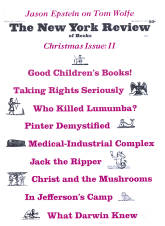In response to:
O Calcutta! from the October 8, 1970 issue
To the Editors:
In thanking Professor Matthew Hodgart of Calcutta for his warm, perceptive review of the new edition of Pepys’s Diary [NYR, October 8] and for the properly small but still fragrant bouquet he offered me and my colleagues, the humble slaves of the Master, I would still like to make a few mild comments for the record.
First, the arithmetic Pepys learned during the diary period was not addition, multiplication, etc., which of course he knew as a small boy, but ars metrica, in this case the very technical and complicated art of measuring ships and the timber that went into their making. By this study Pepys helped to save the British Navy and enabled it to meet the formidable challenge of the Dutch.
Second, as for the diary’s being boring in places, all I can say is that in seven years of reading it, often twelve hours a day, it has never bored me, and I abhor bores. What makes almost everything in Pepys delightful for me and so many other people is that Pepys was both exciting himself and excited by what he described, even by things such as meetings at the Navy Board, a dispute about privies, how many people died in the Great Fire, any of which could be as dull as a dreary sermon in somebody else’s writing. The simple fact is that Pepys had all those qualities that make for a fine writer: a gift for plain, clear English, an observant eye, a curious mind, simplicity, and incurable honesty.
Third, while Professor Hodgart is excellent in appreciating Pepys’s fine taste in almost everything, he cavils at his judgment about Shakespeare and particularly his tepid approval of The Tempest. But what the Professor forgets, and in this he is like almost every other scholar, is that Pepys was commenting on a Restoration version. Many Elizabethan and Jacobean plays were set to music on the Restoration stage, and in the process they were sea-changed into something strange and not always rich. So it was with The Tempest, which was most famous for its Echo song.
Fourth, Professor Hodgart disputes about Pepys’s stone. It was not a kidney stone, he says, but the size of a tennis ball. Our editorial note that the stone was a kidney stone is mostly based on the fact that after Pepys’s death seven stones were found in his left kidney. Professor Hodgart’s tennis ball comes ultimately from Evelyn, who said Pepys’s stone was that size. But it is important to remember that tennis balls change size, and that seventeenth-century tennis balls were considerably smaller than those used by Pancho Gonzalez; I think they were about one inch in diameter. One thing to remember in connection with even this smaller stone is that the operation was a scarifying experience from which Pepys might well have died; another is that he passed more stones during the diary period and that he frequently suffered excruciating pain; a third is that he, a man who loved children, was somehow cheated of having children.
So behind that euphoria on which Professor Hodgart comments is possibly a history of persistent pain and long disappointment. That is one of the several reasons why I think Pepys was a great man. Incidentally, though no one can now find these stones, I swear I saw them thirty years ago, and my wife swears she has seen them more recently: but maybe that was a mirage.
Finally, as for those bawdy passages, which Professor Hodgart gets from Arthur Bryant’s Life, they appear in Bryant because I snuck them out of Magdalene thirty-eight years ago for that Life. Now, there is talk of translating the diary into Spanish, and since much of the bawdiness is in Spanish and shorthand, I rather think it should go into English and longhand. “Professor Hodgart de Calcutta? México habla. Cómo se traducen en inglés palabras como morena y hecho y cul?”
William Matthews
Toronto, Canada
This Issue
December 17, 1970



